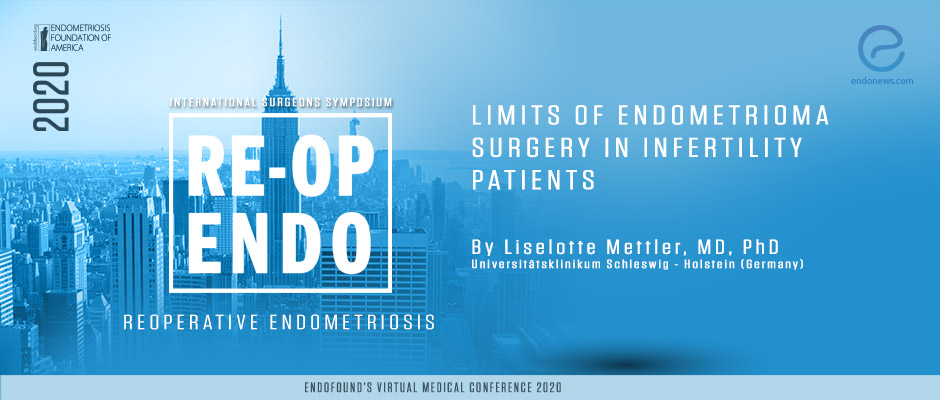Limits of endometrioma surgery in infertility patients - Liselotte Mettler, MD, PhD
Dec 9, 2020
The endometrioma treatment schedule depends on the patient's individual properties.
Key Points
Information for the presentation: Prof. Liselotte Metler, The General Secretary of the International Academy of Human Reproduction and working at Kiel University, Northern Germany. Her main interests and activities are gynecologic endocrinology, reproductive medicine, and gynecologic endoscopy. Her presentation at the 2020 Endofound Medical Conference is about "The limits of endometrioma surgery in infertility patients."
Importance:
- AMH blood levels that show the developing follicles in ovaries tend to be lower in patients with endometrioma and deep endometriosis when compared to healthy women and patients with superficial endometriosis.
- Surgical treatment of endometrioma may result in decreased AMH levels postoperatively.
Highlights:
- Before the decision of surgery for women with endometriosis, the gynecologist should take into account the pregnancy desire, age, past medical/surgical history, ovarian reserve of the patient along with size and accessibility of ovaries, and the presence of symptoms like pelvic pain.
- For the selection of the treatment protocol of endometrioma as surgery-GnRH therapy-or IVF to be the first, the above parameters are important.
Remarks:
- After the clinical suspect of rectal endometriosis infiltration, a recto-ultrasound (RUSG) examination is needed. When the rectal wall is infiltrated, the surgery should be performed by a colorectal surgeon and gynecologist together.
- The decision for excision of endometrioma larger than 3 cm depends on some conditions, such as size and accessibility, symptoms, age and the wish of the patient, ovarian reserve, and past medical/surgical history.
- If there are healthy follicles near the endometrioma and there is hope for future oocyst pick-up, clinicians should rather prefer not to aspirate the endometrioma.
- Surgeons should always be careful when working with ovaries during the surgery as this may cause a lower embryo quality, quantity, and a higher rate of canceled cycles postsurgical ART treatment of endometriotic patients.
Lay Summary
The removal of endometrioma may affect ovarian reserve because healthy follicles near endometrioma could also be excised during this procedure. Another concern about the ovarian reserve is that it may be already low before the surgery. Anti Mullerian Hormone (AMH) is an indicator of ovarian reserve, and it always surges down after excision of endometrioma.
If the patient wishes to get pregnant, the gynecologist is concerned not only with the number of healthy follicles but also with the quality of the ovarian reaction of the patient. There are five key considerations regarding the benefits of the surgery.
- Symptoms: In the presence of pelvic pain the main concern is the removal of the big-sized endometrioma for appropriate comfort of the patient.
- The size of the cyst and the accessibility of the ovary: Transvaginal approach and endometrioma aspiration is not a good idea if there are healthy follicles nearby and there is hope for future IVF cycles.
- The age of the patient and the ovarian reserve: The older the patient the less can get pregnant. The egg yield of the endometriotic patients is lower, and cycle cancellation is higher. As egg yield correlates with the live birth rate, those who have a lower ovarian reserve and/or more severe disease are likely to have poorer outcomes.
- Past medical/surgical history, and
- The wish of the patient.
Considering these 5 criteria above and according to the patient's individual properties treatment choices for endometrioma could be surgery or GnRH therapy. If the patient does not respond to the hormonal treatment, the surgical approach will be on the scene again. Keep contact always with the patient and follow-up the progress of endometrioma during this period is very important. When the patient is older than 37 years and diagnosed with 2 years of primary infertility, the choice for treatment would be IVF first. ESHRE declaration indicates if endometrioma is larger than 3 cm., there is no evidence that cystectomy prior to assisted reproductive technology treatment improves pregnancy rates.
Dr. Metler underlined "The best surgery performed or not, it is definite that the patient wishes to get pregnant at the end."
Research Source: https://www.endofound.org/limits-of-endometrioma-surgery-in-infertility-patients-liselotte-mettler-md-phd?pop=mc
ovarian reserve AMH laparoscopy primary infertility IVF GnRH analogues endometrioma superficial endometriosis deep endometriosis. mc2020

